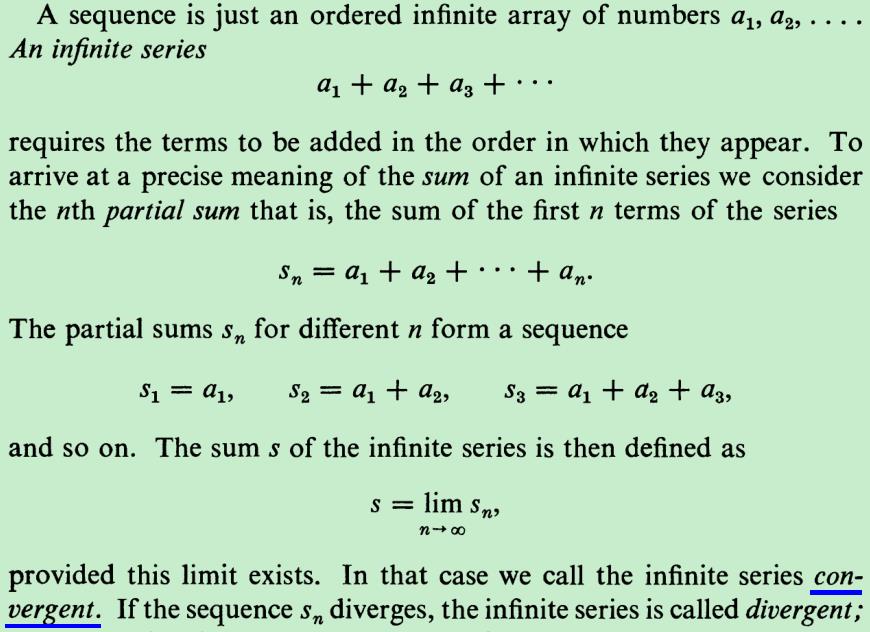深入理解无穷级数和的定义(the sum of the series)
Posted MathJoy
tags:
篇首语:本文由小常识网(cha138.com)小编为大家整理,主要介绍了深入理解无穷级数和的定义(the sum of the series)相关的知识,希望对你有一定的参考价值。
Given an infinite sequence (a1, a2, a3, ...), a series is informally the form of adding all those terms together: a1 + a2 + a3 + ···. To emphasize that there are an infinite number of terms, a series is often called an infinite series.

值得注意的是等式右边并不是左边的和,只是左边的缩写形式。

because when you start from adding up the first two terms of the infinite sequence, and then add the third term, the 4-th term, ..., no matter how much time you spend on adding these terms, you always end up adding up only a finite number of terms , thus you couldn\'t add up an infinite number of terms, so cannot compute their sum by adding one term after another.
An easy way that an infinite series has a sum is if all the $a_n$ are zero for n sufficiently large. Such a series can be identified with a finite sum, so it is only infinite in a trivial sense.
Working out the properties of the series that has a sum even if infinitely many terms are non-zero is the essence of the study of series. Consider the example
![]()
It is possible to "visualize" it has sum on the real number line: we can imagine a line of length 2, with successive segments marked off of lengths 1, ½, ¼, etc. There is always room to mark the next segment, because the amount of line remaining is always the same as the last segment marked: when we have marked off ½, we still have a piece of length ½ unmarked, so we can certainly mark the next ¼. This argument does not prove that the sum is equal to 2 (although it is), but it does prove that it is at most 2. In other words, the series has an upper bound. As for proving the series is equal to 2, we choose $$a_n=1+\\frac12+\\frac14+\\frac18+\\frac{1}{16}+\\cdots+\\frac{1}{2^{n-1}}+\\frac{1}{2^n}$$ and $b_n=2$, then $$a_n<1+\\frac12+\\frac14+\\frac18+\\frac{1}{16}+\\cdots+\\frac{1}{2^{n-1}}+\\frac{1}{2^n}+\\cdots\\leq b_n$$ holds for every nature number $n$ and $\\lim _{n\\rightarrow \\infty }\\left( b_{n}-a_{n}\\right)=\\lim _{n\\rightarrow \\infty }\\frac{1}{2^n} =0$, according to the nested intervals theorem the intersection of all the $[a_n,b_n]$ contains exactly one real number, since 2 is an element of each of these intervals, $1+\\frac12+\\frac14+\\frac18+\\frac{1}{16}+\\cdots+\\frac{1}{2^{n-1}}+\\frac{1}{2^n}+\\cdots = 2$, this proved the sum of the series is 2.
It is also possible to prove $$1 - {1 \\over 2} + {1 \\over 3} - {1 \\over 4} + {1 \\over 5} - \\cdots =\\sum_{n=1}^\\infty {\\left(-1\\right)^{n-1} \\over n}=\\ln(2)$$ using the nested intervals theorem by choosing $a_k=\\sum_{n=1}^{2k} {\\left(-1\\right)^{n-1} \\over n}$ and $b_k=\\sum_{n=1}^{2k+1} {\\left(-1\\right)^{n-1} \\over n}$ for all natural numbers $k$.
While a more general method to get the sum of a series is by taking limit.

As you see, we defined the sum of a infinite series, this result seems not that naturally like 2 + 2 is computed out equal to 4,so is the definition give us the true sum of the infinite series? $\\lim _{n\\rightarrow \\infty }S_{n}$ has a meaning that the number of the first n terms added up increases indefinitely, this is equivalent to $$a_{1}+a_{2}+a_{3}+\\cdots $$, thus defining the sum of a series as the limit of the sequence of its partial sums is intuitively plausible.
Given the definition gives the true sum of the infinite series, the statement that 0.999… = 1 can itself be interpreted and proven as:
${\\displaystyle 0.999\\ldots =\\lim _{n\\to \\infty }0.\\underbrace {99\\ldots 9} _{n}=\\lim _{n\\to \\infty }\\sum _{k=1}^{n}{\\frac {9}{10^{k}}}=\\lim _{n\\to \\infty }\\left(1-{\\frac {1}{10^{n}}}\\right)=1-\\lim _{n\\to \\infty }{\\frac {1}{10^{n}}}=1\\,-\\,0=1.\\,}$
批注:一开始convergent和divergent是对一个sequence来说的,定义如下

但怎么能说级数convergent和divergent了呢?级数,根据上面的定义不就是一个数列的无穷多项依次加起来的一个和式吗?对于一个和式能说convergent和divergent吗?我看不如说一个级数has a sum or not,然后说其部分和组成的数列convergent和divergent似乎比较合适!说一个series converges to a limit L不如说这个series =L。

quoted from http://www.mathcentre.ac.uk/resources/uploaded/mc-ty-convergence-2009-1.pdf
以上是关于深入理解无穷级数和的定义(the sum of the series)的主要内容,如果未能解决你的问题,请参考以下文章